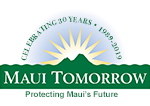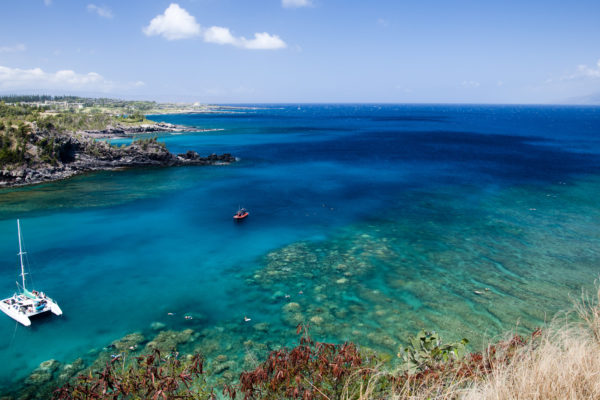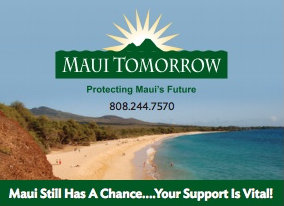By Valerie Monson, Staff Writer
The Maui News
September 7, 2004
With commercial activities banned and more watchful eyes on the scene, have things changed for the better at the Ahihi-Kinau Natural Area Reserve and adjoining Keoneoio?
Yes – and no.
That was the report given to the Ahihi-Kinau/Keoneoio Advisory Group from an ocean biologist Thursday night following a walking site visit earlier in the afternoon.
Dave Gulko, a coral reef biologist with the state’s Division of Aquatic Resources, said much of the destruction caused by humans had decreased since a survey in December when the popular snorkeling places were still overrun with commercial kayaks. But Gulko said he had also noticed some changes for the worse – an unidentified algae that’s collecting on coral and the increase of a venomous sea star that feeds on live coral. Neither of the infestations could be fully explained.
The meeting had its moments of emotion and passion as more than 50 people gathered at the Kihei Community Center with different priorities on protecting the resources that have been trampled by tourists, illegal campers and vandals. Boaters insisted they were doing everything they could to operate in a responsible manner if they were in the area; kayak operators claimed their nonmotorized vessels had even less of an impact; and fishers pleaded with officials not to erect a gate that would block off one of their last remaining fishing grounds at Keoneoio.
Pat Borge, a longtime resident near the bay at Keoneoio who has seen the transformation from a quiet enclave to nightly hangout, said he felt the process had bogged down, leaving the most vulnerable elements of the reserve still under attack. Borge fears that if those delicate assets – two coves and the anchialine ponds – are not protected, they could become like Molokini or Kanahena Bay (also known as Ahihi Bay), overrun with tourists.
“We have no plans to protect the two ponds,” cried Borge. “They should be closed until we have a plan. We talk about educating people, but nobody’s making a move. It’s a natural area reserve.”
Earlier Thursday on a foot tour of the region, Dan Davidson, deputy director of the state Department of Land and Natural Resources, pointed out some of the steps that have been taken since the advisory group began meeting four months ago. Many of those in the group had called for the commercial-activities ban that went into effect in April.
Davidson introduced Matt Ramsey, a natural area reserve system specialist from Oahu, who has been assigned as interim ranger for Ahihi-Kinau and Keoneoio. Ramsey has applied for one of two full-time ranger positions that will be funded by the Hawaii Tourism Authority (HTA) to report illegal activities and educate visitors.
Even though he’s been on the job for only a week, Ramsey has already made his presence felt. He’s come upon poachers, illegal hunters and drinkers. To increase his effectiveness, Ramsey adjusts his schedule to keep miscreants off guard.
“I’ve definitely surprised some people by showing up at 2 a.m.,” he said, noting that all encounters have ended peacefully.
Ramsey will get some support Tuesday when the Hawaii Wildlife Fund sets up a daytime kiosk in a parking area on the Keoneoio side of Kanahena Bay to better inform visitors about the special nature of the reserve. That project is also being funded by the HTA.
Fund Executive Director Hannah Bernard said personnel will be on hand for about four hours a day, seven days a week, to help tourists understand the area and encourage them to snorkel at Kanahena Bay instead of the coves known as Fishbowl and Aquarium, which were showing signs of degradation from too many people. Bernard is also looking for volunteers to staff the kiosk for longer periods. Anyone interested should call 579-9138.
During the site visit, Ramsey and Maui NARS specialist Bill Evanson showed participants the preferred location for a gate that would be locked at night with keys available to those who asked. The barrier would be located above the parking lot where the Hawaii Wildlife Fund will be based because it’s next to some flat lava where vehicles could turn around.
The gate, however, is a long way off, if it ever will come to be, mainly because the state and county can’t decide who has jurisdiction over the road. Nothing could happen on the road without going to the Maui County Council, where public input would be heard.
As to the state of the reserve, Gulko said that impacts by humans have been reduced considerably since the ban on commercial tours was imposed. Gulko said there’s less evidence of scraping by kayaks, fish aren’t as likely to swim up to snorkelers in search of food and it appears that fewer people are using the archaeological sites and coves as toilets.
At the same time, remains of a bonfire were seen in a historic site and directions to one cove had been newly spray painted along the rocks after old graffiti had been removed.
Gulko also said he didn’t see as many large schools of fish in the recent survey, but he didn’t have a reason. Neither could he explain why algae was covering some coral and the population of coral-eating crown-of-thorns sea stars was on the rise. He said more study is needed.
Davidson said Gulko and his team would do another survey in December to see if the changes were related to recent weather conditions or just the summer season.
Divers or other ocean users should leave the sea stars alone, said Gulko. The spiny creatures can cause serious harm to anyone who doesn’t know what they’re doing. They could be increasing in numbers because people have been gathering the sea stars’ natural predators, which would keep them in check.



